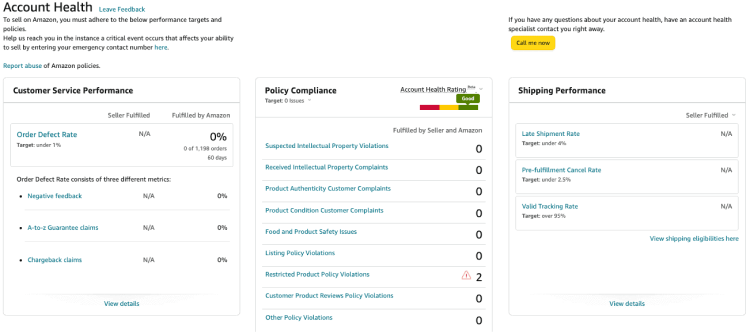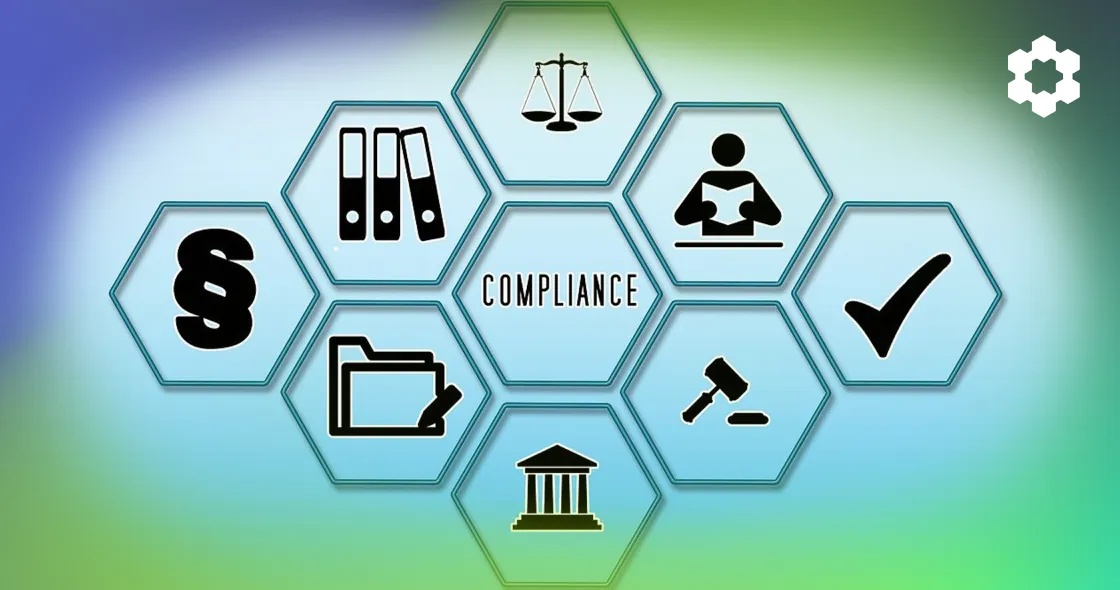What makes Amazon hit that suspend button? It’s not just a random occurrence – there are reasons behind it.
We’ll spill the beans on why Amazon account suspensions happen, whether for peddling counterfeit goods, stepping on someone’s trademark toes, or simply dropping the ball on performance metrics.
We’ll also show you how to whip up a killer Plan of Action (POA) to have Amazon nodding their approval. From diagnosing the root cause of the issue to outlining your comeback strategy, we’ve got you covered.
With this guide as your compass, you’ll be well-equipped to weather the storms of account suspensions and emerge stronger and more resilient than ever.
Understanding Amazon’s Expectations and Policies
Amazon expects sellers and service providers to maintain high performance to ensure the best service for customers. For this reason, the retail giant has program policies and performance targets. Failure to meet these can have serious consequences, including account suspension and a decrease in the number of jobs assigned (for service providers).
Sellers and service providers need to meet specific targets for each metric to maintain good standing.
Amazon’s Performance Status categorizes sellers and service providers based on their adherence to these standards.
Those in “Good Standing” meet all performance targets and can earn more jobs by demonstrating distinguished performance. However, those labelled “Attention” are below one or more performance targets, which can negatively impact their account and job assignments, and may even lead to account suspension.
Compliance with Amazon’s expectations and policies is essential for sellers to maintain their selling privileges and reputation on the platform. It ensures a positive customer experience and allows sellers to continue operating and growing their businesses on Amazon.
What Happens When an Account is Suspended?
An Amazon account suspension occurs when Amazon restricts your access to your account, preventing you from selling on the platform temporarily or permanently.
According to Amazon’s terms of service for sellers, your account may get suspended or terminated if the retailer determines that:
- You have significantly violated the Agreement and don’t rectify the issue within seven days of receiving notice. Unless the breach poses a risk of liability to a third party, Amazon reserves the right to shorten or waive the cure period at its discretion. To remedy the breach, you must provide a written notice specifying the nature of the failure and the timeframe needed for correction.
- Your account has either been flagged by Amazon’s monitoring systems for potential involvement in deceptive, fraudulent, or illegal activities, or there are indications that it could be.
- Your use of the Services has caused detriment, or Amazon’s oversight indicates potential harm to other sellers, customers, or the platform’s lawful concerns.
- Your Account Health Rating falls below the performance targets set by Amazon’s guidelines.
- If Amazon is required to do so by law.
Account Status
Offering services on Amazon is determined by your account status. There are three possible statuses for your Selling Account:
- Active: Your selling account is fully operational, allowing you to sell on Amazon as usual. Payments will be disbursed according to the standard schedule.
- Under Review: While your selling account remains active, it is currently undergoing assessment by Amazon. During this period, funds will be held for 90 days or until the review process concludes, whichever occurs first.
- Suspended: Your selling privileges on Amazon are temporarily revoked, and funds are withheld. In some cases, a suspension notice may include an automatic reinstatement date, eliminating the need for action on your part. Otherwise, you may need to submit a Plan of Action for reinstatement. Funds will be held for 90 days or until your account is reinstated to “Active,” whichever happens first.
Suspension Period
The duration of an Amazon account suspension varies depending on the reason for the suspension and the actions taken by your team to resolve the issue. In some cases, suspensions may be lifted within a few days or weeks if you provide sufficient evidence of compliance or rectify the underlying issues promptly.
However, more severe violations or repeat offences may result in longer suspensions or permanent account closures.
During the suspension period, you are typically required to address the specific issues outlined by Amazon, such as providing additional documentation, resolving customer complaints, or implementing corrective measures to prevent future violations.
Once Amazon verifies that you have taken appropriate action and addressed the concerns, they may reinstate the account, allowing you to resume selling on the platform.
You must communicate effectively with Amazon’s seller support team, follow the instructions, and demonstrate a commitment to compliance and customer satisfaction to expedite the suspension resolution.
Additionally, you can seek assistance from professional services specializing in Amazon account reinstatement to navigate the appeal process effectively and increase the likelihood of a favorable outcome.
3 Main Reasons for Amazon Account Suspensions

Amazon account suspensions can be a nightmare for your business, disrupting operations and threatening livelihoods. Understanding the main reasons behind these suspensions is crucial for protecting your Amazon account.
Factors like policy violations and poor account health metrics can trigger suspensions. By grasping these reasons, you can proactively address potential issues, maintain compliance with Amazon’s guidelines, and safeguard your businesses from the devastating consequences of account suspensions.
1. Policy Violations
Violating Amazon ToS can have grave implications, including account suspensions. Here’s how such violations can lead to selling restrictions with examples and tips to prevent them.
Listing Prohibited Items
Selling prohibited items on Amazon’s marketplace can lead to account suspension. Prohibited items include illegal drugs, firearms, counterfeit goods, animals, and items that infringe on intellectual property rights. For example, attempting to sell “parts or products, including fur and feathers, from endangered or threatened species” can result in account suspension.
Therefore, before listing a product, thoroughly review Amazon’s restricted product list and ensure that your products comply with all applicable laws and regulations. Additionally, conducting due diligence to verify the authenticity and legality of products can help prevent policy violations.
Violating Product Authenticity Policies
Selling counterfeit or inauthentic products violates Amazon’s policies and can result in account suspension. For instance, if you knowingly sell counterfeit electronics or falsely claim that products are authentic when they are not, your account may be suspended.
Per Amazon, examples of prohibited products include:
- Bootlegs, fakes, or pirated copies of products or content
- Products that have been illegally replicated, reproduced, or manufactured
- Products that infringe another seller’s IP rights, including brand name
To prevent account suspension due to counterfeiting, source products from reputable suppliers and verify the authenticity of your inventory before listing it on Amazon. For that reason, ensure the maintenance and accuracy of your inventory records such as invoices. While you may omit pricing details from these documents, tampering or misleading editing violates Amazon’s anti-counterfeiting policy, resulting in enforcement actions against your account.
Manipulating Product Reviews
Attempting to manipulate product reviews, such as offering incentives in exchange for positive reviews or using fake accounts to leave favorable feedback, violates Amazon’s review policies. Sellers found engaging in review manipulation risk account suspension.
Prioritize providing excellent customer service and delivering high-quality products to earn positive reviews. Encouraging genuine feedback from satisfied customers and refraining from incentivizing reviews can help maintain compliance with Amazon’s review policies.
Intellectual Property Infringement
Using copyrighted materials, trademarks, or logos without authorization from the rights holder constitutes intellectual property (IP) infringement. For example, selling merchandise featuring copyrighted images or using trademarked brand names in product listings without permission can lead to account suspension.
Always obtain proper authorization before using intellectual property and avoid using unauthorized materials in their listings. Amazon recommends enrolling your brand in the Brand Registry program to gain access to tools and features that enable you to assert greater control over your products and listings.
For instance, you can use tools like proprietary text and image search, which help detect and report potential IP infringements. Additionally, Brand Registry allows you to create and manage your product listings more effectively, reducing the risk of unauthorized sellers hijacking your listings or selling counterfeit goods.
Deceptive Practices
Engaging in deceptive practices, such as misleading product descriptions, false advertising claims, or misleading pricing information, can lead to account suspension. Deceptive practices undermine trust and integrity within the marketplace.
Ensure that product listings accurately represent the features, specifications, and pricing of items being sold. Transparency and honesty in product descriptions and advertising materials are essential for building trust and avoiding potential policy violations.
2. Poor Amazon Account Health
Been suspended for consistently failing to meet shipping deadlines or providing inadequate customer service?
On your Seller Central account, a valuable tool known as the Account Health Rating (AHR) assesses your adherence to Amazon’s selling policies. Your rating is determined by several factors, including unresolved policy violations, their severity, and your overall impact on customer experience through selling activities.
The AHR is presented as a color-coded index, with green indicating good standing (based on a score of 200-1,000), yellow for at-risk status (100-199), and red for critical issues (below 99), providing a quick overview of your compliance status.

Poor Amazon account health indicates that your performance metrics and adherence to Amazon’s AHR-related policies are below the expected standards. This can manifest in various ways, including low seller ratings, high order defect rates, late shipment rates resulting in cancellations, a high number of A-to-Z Guarantee claims, and violating any of the following policies:
- Amazon Anti-Counterfeiting policy
- Amazon Brand Name policy
- Amazon Intellectual Property policy
- Amazon Marketplace Fair Pricing policy
- ASIN Creation policy
- Communication guidelines
- Customer Product Reviews Policies
- INFORM Consumers Act
- Product condition guidelines
- Product detail page rules
- Product guidelines for adult products
- Product guidelines for selling software
- Product safety and compliance
- Restricted Products policy
- Selling policies and seller code of conduct
Monitoring performance targets regularly and proactively addressing issues is crucial for maintaining a healthy Amazon account. This may involve:
- Improving order fulfillment processes
- Resolving customer disputes promptly
- Ensuring compliance with Amazon’s policies
- Seeking assistance from third-party experts when necessary
Maximize savings by using SoStocked’s FBA Size Tier Optimizer tool to align your Amazon products and packaging with the most cost-effective shipping weight tiers. Simply input your unit preferences and product details to identify opportunities for size reduction and qualify for lower FBA size tiers. This can lead to substantial savings on both storage and shipping fees. Afterward, explore additional savings with our complimentary Amazon Master Carton Calculator tool.
3. Compliance Issues Regarding Account Verification
Account verification is a crucial aspect of maintaining compliance on Amazon. Failing to adhere to the platform’s requirements regarding seller account verification can hurt your business. Here’s how compliance issues in this area can lead to such Amazon account suspensions:
Incomplete or Inaccurate Information
Providing incomplete or inaccurate information during account verification can raise red flags. This may include incorrect business details, missing documents, or failure to verify identity. For instance, a seller registers an account with incomplete business information and fails to verify their identity, leading Amazon to suspect fraudulent activity.
Failure to Submit Required Documents
Amazon often requires sellers to submit specific documents for account verification, such as business licenses, tax information, or identity verification documents. Failing to provide these documents or submitting invalid ones can result in account suspension.
Suppose you neglect to submit your tax information as requested by Amazon. In that case, Amazon may flag your account for suspension due to non-compliance.
The Impact of Account Suspension on Amazon Sellers
Loss of Revenue
With account suspension, you lose the ability to list and sell products on Amazon’s platform, resulting in an immediate stop to revenue generation. This loss can be significant, especially for sellers who rely heavily on Amazon for their sales.
Damage to Reputation
Account suspension can tarnish your reputation and credibility on the platform. Customers may perceive you as unreliable or untrustworthy, damaging your brand image long-term.
Withheld Funds
You may face financial repercussions, including frozen funds and withheld disbursements. Amazon may hold funds in escrow for an extended period, further exacerbating cash flow issues.
Inventory Challenges
You may encounter difficulties managing your inventory effectively during suspension periods. Without the ability to sell on Amazon, excess inventory may accumulate, leading to higher storage fees and potential losses.
Operational Disruption
Account suspension disrupts normal business operations, requiring you to allocate resources toward resolving the suspension and reinstating your account. This diversion of time and effort can impact other aspects of the business, such as customer service and product development.
Legal Ramifications
In severe cases, account suspension may lead to legal implications, especially if you can’t resolve compliance issues or disputes with Amazon. Legal proceedings can be time-consuming and costly, further straining your resources.
Overall, the impact of account suspension on your business extends beyond immediate financial losses, affecting brand reputation, operations, and legal standing. It underscores the importance of adhering to Amazon’s policies and maintaining compliance to mitigate the risk of suspension and protect long-term business success.
How To Appeal Amazon Account Suspensions?

In the event of ToS breach, Amazon will immediately inform you of any termination or suspension through email or Seller Central, detailing the reasons and appeal options, unless disclosing such information could impede investigations into deceptive, fraudulent, or illegal activities, or enable circumvention of its safeguards.
Take the following steps upon receiving a suspension notice from Amazon:
1. Review Suspension Notice
Carefully read the suspension notice to understand the reason(s) for suspension and any specific actions required to address the issue. Pay close attention to the timeline and instructions provided by Amazon.
2. Assess Impact
Evaluate the impact of the suspension on your business, including the loss of revenue, potential damage to reputation, and implications for inventory management and cash flow.
3. Gather Information
Collect all relevant documentation and information related to your account and the issue cited in the suspension notice. This may include invoices, order details, customer communications, and any other supporting evidence.
4. Contact Amazon Seller Support
Reach out to Amazon Seller Support through the Seller Central platform to seek clarification on the suspension and discuss potential steps for resolution. Be prepared to provide detailed information and evidence to support your case.
5. Develop a Plan of Action
Based on the reason(s) for the suspension and guidance from Amazon Seller Support, develop a comprehensive action plan to address the issues identified and regain compliance with Amazon’s policies.
An effective Amazon improvement action plan should include the following components:
- Acknowledgment of the Issue: Clearly state the reason for the suspension and demonstrate an understanding of the violation that led to it.
- Root Cause Analysis: Identify the underlying reasons behind the violation, whether due to a misunderstanding of Amazon’s policies, operational challenges, or other factors.
- Corrective Measures: Outline specific steps taken or to be taken to address the issue and prevent recurrence. This may include process improvements, staff training, policy revisions, or other corrective actions.
- Timeline: Provide a timeline for implementing the corrective measures, including milestones and deadlines for each action item.
- Prevention Strategies: Describe proactive measures to prevent similar violations in the future, such as regular audits, monitoring systems, or compliance checks.
- Communication Plan: Explain how you will communicate with Amazon to provide updates on progress and ensure transparency throughout the improvement process.
- Commitment to Compliance: Reaffirm your commitment to complying with Amazon’s policies and maintaining high standards of performance in your selling operations.
- Contact Information: Include contact details for the person responsible for overseeing the implementation of the improvement action plan and serving as the point of contact for Amazon.
By including these elements in your improvement action plan, you can demonstrate to Amazon your commitment to rectifying the issues that led to the suspension and ensure a smoother path toward account reinstatement.
6. Submit Appeal
Prepare and submit a well-crafted appeal letter to Amazon outlining the steps taken to address the suspension and prevent future violations. Clearly articulate your understanding of the issue, the corrective measures implemented, and your commitment to maintaining compliance. Be sure to maintain a tone of honesty and professionalism throughout the correspondence.
7. Monitor Communication
Stay vigilant for any communication from Amazon regarding your appeal and respond to requests for additional information or clarification. Timely and transparent communication can expedite the resolution process.
8. Implement Changes
If your appeal is successful and your account is reinstated, take proactive steps to implement any changes or improvements Amazon recommends to prevent future suspensions.
10 Strategies to Stay Compliant on Amazon
1. Stay Informed
Regularly review Amazon’s policies and guidelines to ensure compliance with their terms of service. As Vanessa Hung said in a LinkedIn post:
“Figuring out Amazon changes before anyone else can help you avoid so many headaches. Even though they love to modify everything without a hint, having a step ahead of understanding Amazon’s range of actions can help visualize your next moves.”
It’s best to familiarize yourself with the rules governing product listings, customer communication, and account management.
2. Maintain Accurate Product Listings
Ensure that your product listings are accurate and up to date. Provide clear and detailed product descriptions, images, and specifications to avoid customer misunderstandings or complaints. Be sure to follow Amazon’s requirements for product titles and images.
Did you know that sellers now have the convenience of generating Amazon listings for products found on their Direct-To-Consumer (DTC) sites? Using advanced AI technology, Amazon’s newest tool automatically extracts information from a website’s URL to create product listings.
While you may be tempted to use this tool for listing creation, be aware that “accuracy is a key concern,” Hung warns. When creating a listing using this tool, Hung recommends that “your DTC website has high-quality product information, clear descriptions, and relevant keywords.”
“Don’t blindly trust AI-generated content. Review the listings produced by the tool and make any necessary adjustments to ensure accuracy and brand voice,” she added.
3. Monitor Performance Metrics
Keep a close eye on your performance metrics, including order defect rate (minimize claims and chargebacks), late shipment rate, and customer feedback. Address any issues promptly to prevent them from escalating and leading to account suspensions.
4. Provide Excellent Customer Service
Deliver exceptional customer service by promptly responding to customer inquiries, addressing any issues or concerns, and processing returns and refunds in a timely manner. Happy customers are less likely to file complaints or leave negative feedback.
5. Source Products Legitimately
Ensure that you source your products from legitimate suppliers and manufacturers. Avoid counterfeit or unauthorized goods, as selling such items can lead to account suspensions and legal consequences.
6. Maintain Good Inventory Management
Keep track of your inventory levels to prevent stockouts or delays in fulfilling orders. Utilize the leading Amazon inventory management software SoStocked to track inventory levels, replenish stock as needed, and avoid overselling.
7. Follow Amazon’s Communication Guidelines
Adhere to Amazon’s communication guidelines when interacting with customers. Avoid sending unsolicited messages, spam, or promotional content that violates Amazon’s policies.
8. Handle A-to-Z Claims Promptly
Address A-to-Z claims and customer disputes promptly and professionally. Provide evidence to support your case and work towards resolving the issue amicably to avoid escalation.
9. Utilize Amazon Brand Registry
Enroll your brand in Amazon Brand Registry to protect your intellectual property rights and prevent unauthorized sellers from listing your products. This can stop counterfeit and infringement issues that could lead to account suspensions.
10. Seek Professional Assistance if Needed
If you’re unsure about any aspect of selling on Amazon or need assistance with compliance issues, consider seeking guidance from experts in Amazon seller support.
Rebounding from Amazon Account Suspensions
Amazon account suspensions are not random occurrences; they are typically triggered by specific violations of Amazon’s policies and guidelines. From selling counterfeit goods to poor AHR ratings, there are several reasons why Amazon may suspend an account. However, with the right strategies, you can prevent future suspensions and protect your Amazon brand.
Crafting a well-structured action plan is crucial for appealing suspensions effectively. By diagnosing the root cause of the issue and outlining a comeback strategy, sellers can increase their chances of reinstatement.
Additionally, staying informed about Amazon’s expectations and policies, maintaining accurate product listings, monitoring performance metrics, and providing excellent customer service is essential for preventing future suspensions.
Despite best efforts, navigating the appeal process alone can be daunting. That’s why it’s advisable to consider hiring the services of Seller Central operations experts. With their account management expertise and dedicated support, you can increase your chances of overturning account suspensions and resume selling on Amazon with confidence.








